Introduction
Every state in the United States and the world experience some sort of crime at one time or another. Texans experience crimes that come in different forms. To correctly assess and measure the trends of crime, Texas takes part in the Uniform Crime Reporting Program (UCR) which enables the indexing of crime by primary analysis.
The Crime Index
The crime index is a statistical summary tool that is used by the Uniform Crime Reporting Program (UCR) to map crime variations and trends. All the crimes in this group are regarded as dangerous either because of how frequently they are committed or because of the nature of the crime; therefore, they are a challenge to the law enforcement agencies in Texas.
Crimes in the Crime index can further be categorized as being either violent or property crimes. Violent crimes include forceful rape, murder, manslaughter, assault, and robbery among others. Property crimes include theft of the motor vehicle, larceny-theft, and burglary among others.
Crime Analysis in Texas
Crime trends are analyzed in two different methods: There is crime volume method and crime rates method.
Crime volume is done by basically comparing the number of crimes from year to year. These can be reported crimes, crimes committed, or studied crimes.
For crime rates, crime studies are compiled in such a manner to compensate for the geographical diversity of the state of Texas. The crime rates method puts into consideration the number of people affected by the crime and the population density. This report generally reports crimes per 100,000 Texans.
Crime volume in Texas
In the year 2008, An estimated 1,107,024 offenses were reported and recorded in Texas. This was a 2.3% increase compared to the year 2007 figures. Besides that, a total of 6,003 Arson cases were reported which represented a drop of 8.3% from the year 2007.
Crime Volumes in Texas between 1994 and 2008
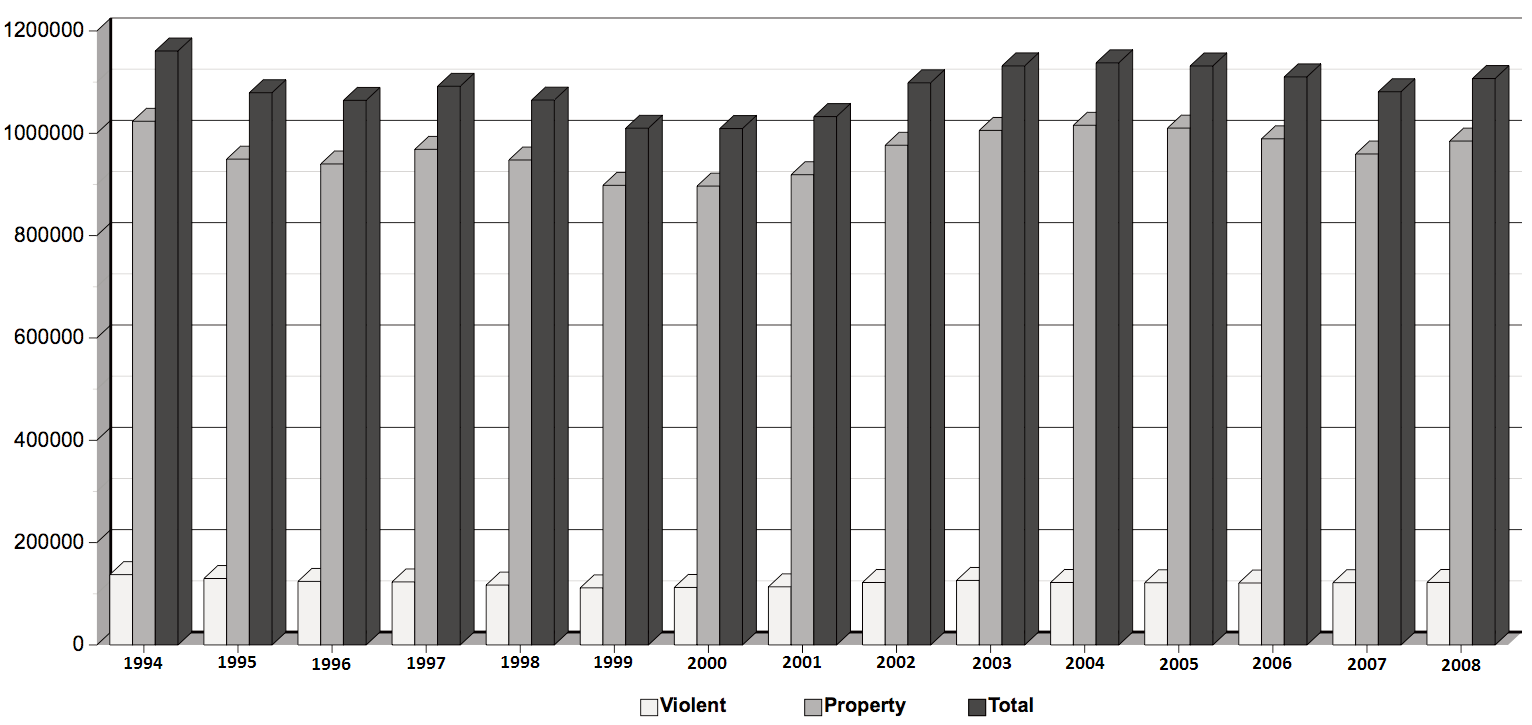
Crimes by volume index
Violent Crime Data
Property crime Data
Total accumulated Crimes comparison (2007 – 2008)
Crime rates in Texas – 2008
In 2008, the estimated crime rate in Texas, which has a population of 23,904,380 was 4631.1 crimes for every 100,000 Texans. This figure compared to the 2007 figures show an increase compared to the 2007 figures by a rate of 0.7%.
Annual Texas Crime Trends – 2008
From the graph below, it is easy to note that the peak month of crime in 2008 in the state of Texas was July, with a recorded offense numbering up to 100,000. February recorded the lowest levels of criminal activity for the whole year as per the graph below.
Monthly Texas crime index
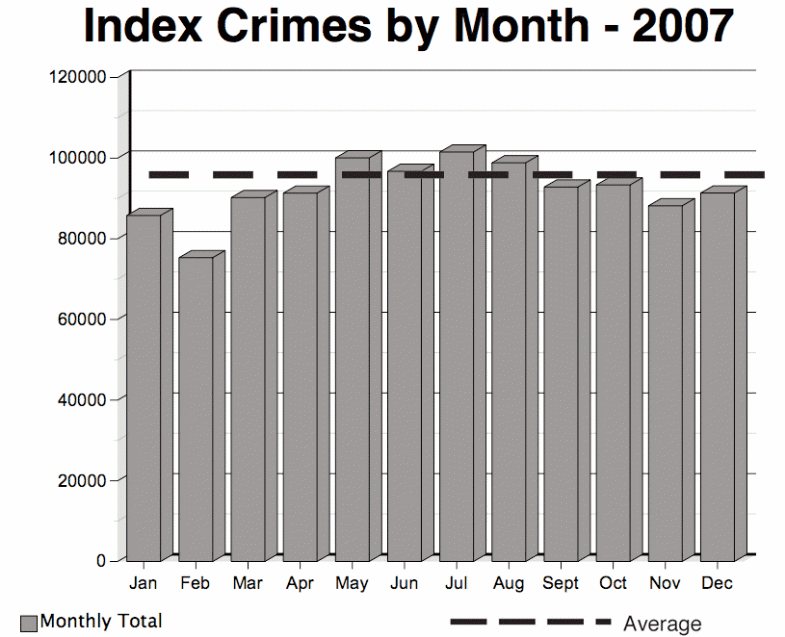
Types of Crimes
The analysis of general crime types in Texas can be easily grouped into the two categories we discussed earlier, that is crimes against persons, commonly referred to as violent crimes and property crimes. In comparing the two crime types for the year 2008, we will see that 89% of the crimes were property crimes while the rest 11% were violent crimes.
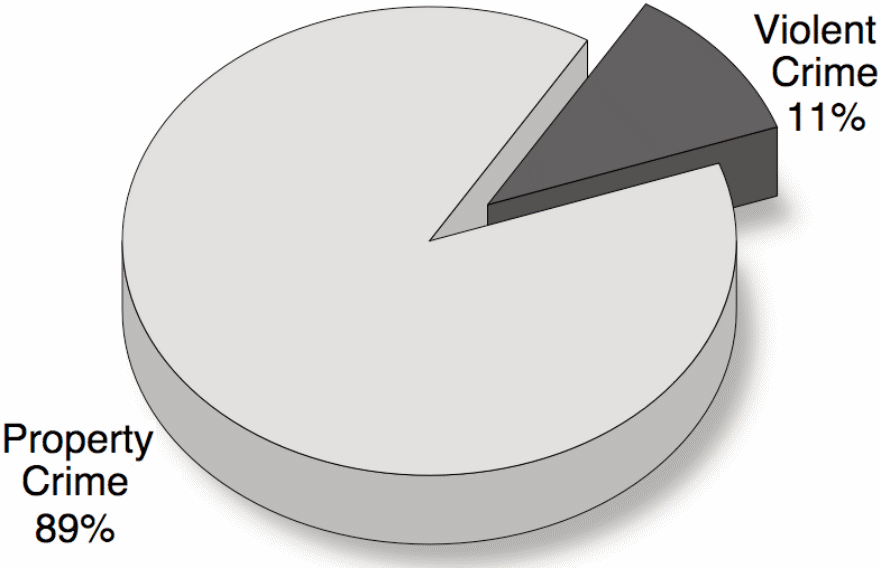
Violent crimes
Violent crimes involve personal confrontations between the crime perpetrator or perpetrators and the crime victim. Violent crimes are considered more severe than property crimes.
In 2008, a total of 122,192 violent crimes were committed, increasing by 0.4% compared to 2007. The crime rate for violent crimes was 511.2 crimes for every 100,000 people; this was a decrease of 1.2% compared to 2007.
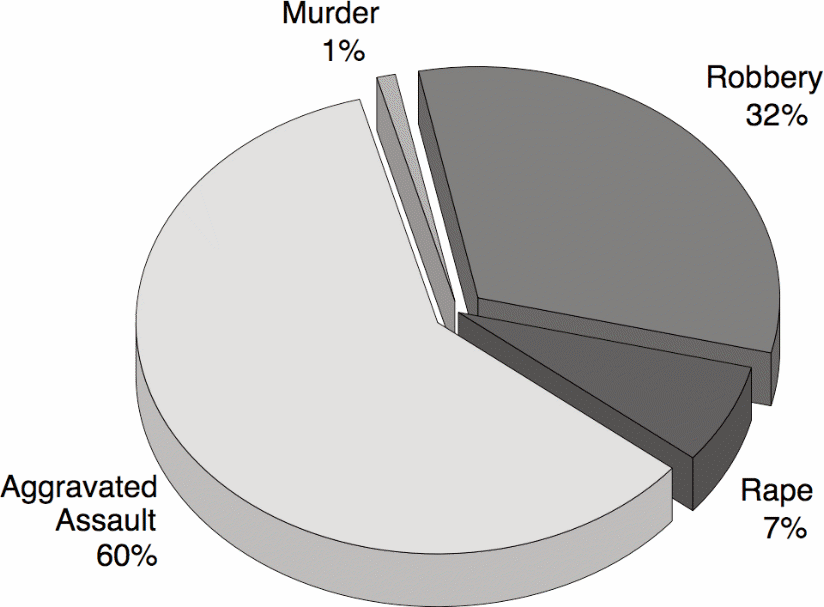
Violent Crime Index for the past 10 years in Texas
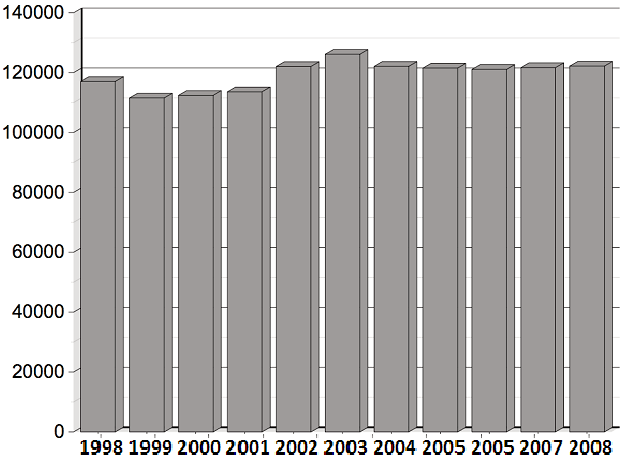
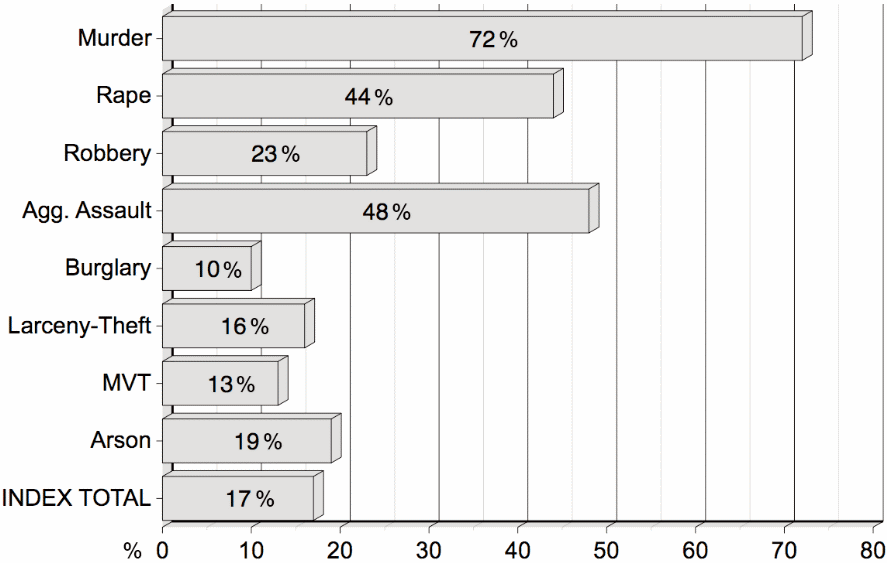
Property Crimes
The estimated number of property crimes in the year 2008 was 984,832. This shows us an increase by 2.6% from the 2007 statistics. The Property crime rate for 2008 was 4,119.9 property crimes per 100,000 people, a 0.9% increase compared to 2007 figures.
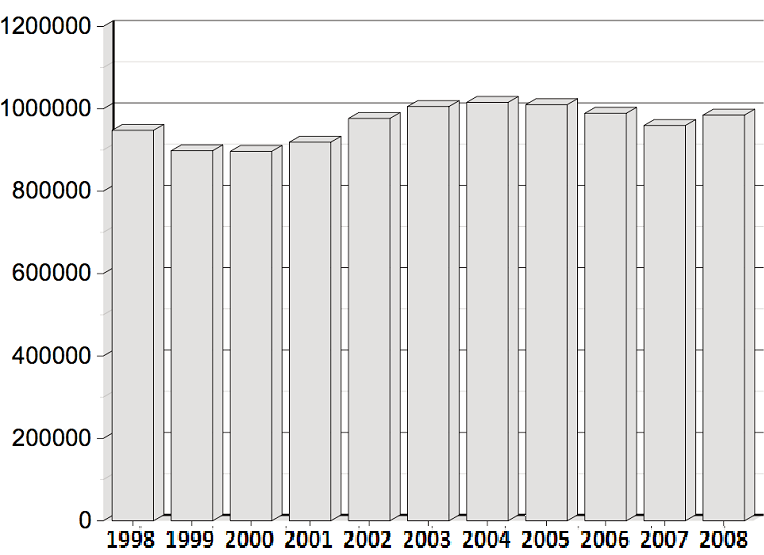
Most of the property crimes were larceny-theft, accounting for 65% of all the property crimes, followed by burglary at 23% and theft of motor vehicles at 10%.

Property Value
The commission of crime index for 2008 found that property worth more than $2 billion was stolen in Texas. Only goods worth $550 were recovered by the Texas state police.
Arson
Arson crimes increased by 6.0% in 2008 compared with 2007 cases. The destruction of property as a result of arson crimes in 2008 was estimated at over $128 million.
Arson cases comparison in 2007 and 2007
Accumulated figures for Texas’ most requested arrests
Texas law enforcement officers assaulted or killed in the year 2008
In 2008, three officers of the law were feloniously killed in the line of duty as a result of criminal activity. A total of nine officers were killed during the year in accidents that relate to their duty. In 2007, 4,396 officers were assaulted but the number rose by 17.9 percent in 2008 to 5,184.
Hate Crime
Hate crime, according to the Texas crime act is a crime that is motivated by hatred and prejudice. This can be caused by prejudice based on sexual orientation, disability, ethnicity, religion, and race.
Bias Motivation
Most reported crimes in Texas in 2008 were racial.
The second most reported bias was sexually followed by religion then the disability.
Frequency of crime occurrence in Texas
This is an estimate of the frequency in which crime is committed in Texas for both property crime and violent crime.
Violent crimes
According to the Justice Research & Statistics Association, murder is committed in Texas after every 5 hours and 49 minutes. A citizen is raped every one hour while robbery occurs every fifteen minutes. Aggravated assault takes place every 7 minutes.
Property crimes
A motor vehicle is stolen or vandalized every six minutes in Texas; a burglary occurs every two minutes and larceny cases take place after every fifty seconds. Combining all the figures will show that crimes take place in Texas every 29 seconds.
Injuries
The efficiency of the reporting officer mainly determines the extent of the injuries that victims of violence sustain. All injuries sustained in a crime are noted at the time of crime reporting and recording. However, the information that will later be noted on medical examination, whether the victim suffered more severe injuries or less than those recorded by the recording officer, this information will not be inserted in the complainant’s violence report.
Most reported cases in Texas in 2008 involving injuries were minor, accounting for 54 percent of all the cases. 42 percent of these cases were domestic, that is to say, they occurred on the family level. Of these, a total of 4 percent of all injuries were serious.
Reported lacerations in Texas accounted for 32 percent of all the injuries that resulted from violent crime. 11 percent of the cases reported later was that the injured victims had broken bones while 28 percent of the injuries reported possible internal injuries.
Weapons
The most widespread weapons that were used in the year 2008 to commit a crime in violent cases was forceful physical use of hands, fists, and feet, accounting for 78 percent of all the violent incidents in Texas.
9 percent of the reported violence cases involved the use of threats and intimidation, a crime that Texas law enforcement considers very serious. Other weapons that were used to commit violent crimes were firearms, accounting for 3 percent of the weapons used, knives and other cutting instruments (2 Percent), blunt objects (2 percent), and other weapons amounting to 5 Percent for all the cases. Other weapons, in this case, included poison, motor vehicles, fire, explosives, drugs, unknown weapons, and other miscellaneous weapons.
Case clearances
According to the Uniform Crime Reporting (UCR), an offense can be cleared only after the law enforcement officers have positively identified the offender, gathered sufficient evidence to press charges and the suspected is taken into custody. The law is a jigsaw and sometimes, many suspects can be arrested in an attempt to clear one offense or at times one offender taken into custody can help clear many offenses on record. When an element that is beyond the control of the law enforcement officers prevents the pressing of charges of an offender or there exists no offender, the law enforcement may exceptionally clear a crime.
In 2008, 17 percent of all cases reported were cleared either by arrest or by other means. 40 percent of the reported violent crimes were cleared while 14 percent of the property crimes were cleared. It is easier to clear a violent crime because often, the offender confronts the victim and it is, therefore, easy to identify and arrest the perpetrator since they can be easily identified.
In the same year 2008, 14 percent of all cases solved represented; involved minors under the age of 18, meaning that 10 percent of all violent crimes and 16 percent of property crimes involved minors below the age of 18.
Conclusion
There is a need to implement serious self-defense and personal security strategies in the state to protect its citizens and their loved ones from becoming victims of such dreaded crimes.
Crimes are more recorded in urban centers and towns more compared to rural areas in Texas and the whole US in general. This is because of many factors including population density, the economic crunch, and decay in moral behavior in the United States.
As time goes by it will be witnessed that the numbers of crimes against people with disabilities will increase after viewing the trends in crime against them. As much as this can be treated as any other hate case, the rates at which the cases are increasing are alarming and need urgent attention. The state of Texas and the United States of America administration as a whole must try to come up with proper ways that will help in curbing these crimes and make the life of the American people safe.
Crime facts in Texas for 2008 at a glance
- An estimated 1,107,024 offenses were indexed in Texas State in 2008. 17 percent of these cases were cleared.
- The rate of crime in Texas in 2008 reached an index of 4,631.1 per every 100,000 Texans.
- In 2008, the law enforcement officers in Texas arrested 1,172,501 suspects. Out of these, 12 percent were aged 16 years and below.
- Property valued at 1,990,851,950 was stolen in the Texas state in 2008 and out of these, only $550 worth of property was recovered.
- Larceny-theft accounted for 59 percent of all crimes committed. The clearance rate for this crime in 2008 was 16 Percent.
- In all the murders reported in the year, 68 percent involved the use of firearms. All other weapons used in murder account for the remaining 32 percent.
- An estimated 73,570 crimes were aggravated assaults. These crimes were committed using fists, hands, and feet.
- Of all burglaries reported in the year 2008, 67 percent were residential. This means that residential burglaries are very common in Texas.
- A total of 94,026 motor vehicles were stolen, resulting in a loss of $859,745,598 in the year 2008.
References
Adams, Pete. (2008). California Crime and Intelligence Analysts Association (CCIAA). Web.
Bernake, Ben S. (2007). Subprime Mortgage Lending and Mitigating Foreclosures. The House Committee on Financial Services. Web.
Bernanke, B.S. (2008). The Economic Outlook. Report for the House of Representatives. Washington, D.C.: Government Printing Office.
Boba, R. and J. Crank. (2008). “Institutionalizing Problem-Oriented Policing: Rethinking Problem Identification, Analysis, and Accountability,” Police Practice and Research 9(5). Web.
Braga, A. and D.L. Weisburd, (2006). “Problem-Oriented Policing: The Disconnect Between Principles and Practice,” in Police Innovation: Contrasting Perspective, Dallas, TX, Cambridge University Press.
Goldstein, H. (2003). “On Further Developing Problem-Oriented Policing: The Most Critical Need, the Major Impediments, and a Proposal,” Monsey, New York: Criminal Justice Press.
Goldstein, H. (1993). Problem-Oriented Policing. New York: McGraw-Hill.
Kelly, Ann. (2008). Council (NSGIC) Annual Conference. Keystone, Colorado: National States Geographic Information. Web.
Lahart, J. (2007). “Egg Cracks Differ in Housing, Finance Shells.”. The Wall Street Journal. New York. Web.
Lilly, Cullen, & Ball. (2008). Criminological Theory (4th) Sage Publications Criminology. Texas. Web.
Messner, S.F. and D. Vlahov, (2007): “Policing, Drugs, and the Homicide Decline in Texas in the 1996,” Criminology 45(2) (385–414).
Mummolo, Jonathan, and Bill Brubaker. (2008) “As Foreclosed Homes Empty, Crime Arrives.” Washington DC. The Washington Post, 27. Web.
Sampson, R.J. and S. Raudenbush, (1999) “Systematic Social Observation of Public Spaces: A New Look at Disorder in Urban Neighborhoods,” Chicago, US. American Journal of Sociology.
Wilson, J.Q. and G. L. Kelling, (1982). “Broken Windows: The Police and Neighborhood Safety,” Atlantic Monthly 249.
Venkatesh, S.A. (2006) “Off the Books: The Underground Economy of the Urban Poor.” Cambridge, Massachusetts: Harvard University Press.